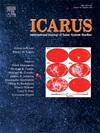尘埃冲击等离子体膨胀特性的实验室测量
IF 2.5
2区 物理与天体物理
Q2 ASTRONOMY & ASTROPHYSICS
引用次数: 0
摘要
碰撞电离过程为空间尘埃粒子的灵敏探测和分析提供了一种方法。高速撞击固体表面的尘埃颗粒会蒸发并部分电离。产生的瞬态撞击等离子体羽流的特征对于理解由天线仪器探测到的空间尘埃撞击信号或优化尘埃仪器具有重要意义。利用延迟线探测器(DLD)实验测量了尘埃撞击等离子体中离子的角速度分布。一个小的钨靶暴露在微米和亚微米大小的铁粉尘颗粒的影响下,使用科罗拉多大学的粉尘加速器设施。来自冲击等离子体的离子在无场区域膨胀,并被DLD检测到。根据所记录离子的时空分布计算出其角速度分布。在2 ~ 5、10 ~ 15和20km/s的冲击速度范围内进行了速度分布测量。在最低尘埃速度范围内,离子速度分布相对较窄(≤10 km/s),但在较高尘埃撞击速度范围内,离子速度分布明显较宽(超过50 km/s)。速度分布可以分解为碰撞等离子体中最常见的离子种类(Fe+, Na+, C+和H+)的贡献。测量结果表明,当尘埃撞击速度大于10 km/s时,离子的平动能约为3 ~ 8 eV,而叠加热能约为1 eV,随撞击速度和离子种类的变化不大。在10 ~ 15 km/s的速度下,对110次尘埃撞击信号进行平均,得到了离子角分布,与余弦分布一致。本文章由计算机程序翻译,如有差异,请以英文原文为准。
Laboratory measurements of the expansion characteristics of dust impact plasmas
The impact ionization process provides a method for the sensitive detection and analysis of dust particles in space. Dust particles impacting solid surfaces at high velocity evaporate and partially ionize. The characterization of the generated transient impact plasma plume is important for the understanding of dust impact signals detected in space by antenna instruments, or for the optimization of dust instrumentation. The angular and velocity distributions of the ions emerging from the dust impact plasma are measured experimentally using a Delay-Line Detector (DLD) setup. A small tungsten target is exposed to the impacts of micron- and submicron-sized iron dust particles using the dust accelerator facility operated at the University of Colorado. The ions from the impact plasma expand in a field-free region and are detected by the DLD. The angular and velocity distributions are calculated from the spatial and temporal distributions of the recorded ions. The velocity distribution measurements are performed for dust impact velocity ranges of , , and >. The ion velocity distribution is relatively narrow (≤ 10 km/s) for the lowest dust velocity range, but significantly wider (exceeding 50 km/s) for the higher dust impact speeds. The velocity distribution can be decomposed into contributions from the most prevalent ion species in the impact plasma (Fe+, Na+, C+, and H+). The measurements suggest that for dust impact speeds greater than 10 km/s the translational energy of the ions is in the range of about 3–8 eV, while the superimposed thermal energy is about 1 eV, with only a weak variation with impact speed and ion species. The ion angular distribution was measured by averaging the signals from 110 dust impacts from a 10–15 km/s dust impact speed and is consistent with a cosine distribution.
求助全文
通过发布文献求助,成功后即可免费获取论文全文。
去求助
来源期刊

Icarus
地学天文-天文与天体物理
CiteScore
6.30
自引率
18.80%
发文量
356
审稿时长
2-4 weeks
期刊介绍:
Icarus is devoted to the publication of original contributions in the field of Solar System studies. Manuscripts reporting the results of new research - observational, experimental, or theoretical - concerning the astronomy, geology, meteorology, physics, chemistry, biology, and other scientific aspects of our Solar System or extrasolar systems are welcome. The journal generally does not publish papers devoted exclusively to the Sun, the Earth, celestial mechanics, meteoritics, or astrophysics. Icarus does not publish papers that provide "improved" versions of Bode''s law, or other numerical relations, without a sound physical basis. Icarus does not publish meeting announcements or general notices. Reviews, historical papers, and manuscripts describing spacecraft instrumentation may be considered, but only with prior approval of the editor. An entire issue of the journal is occasionally devoted to a single subject, usually arising from a conference on the same topic. The language of publication is English. American or British usage is accepted, but not a mixture of these.
 求助内容:
求助内容: 应助结果提醒方式:
应助结果提醒方式:


